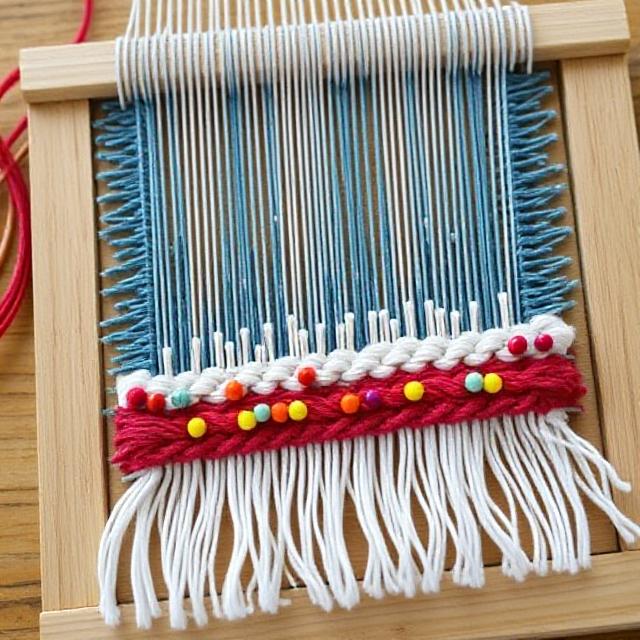Pin Loom Projects:Explore It
In the world of fiber arts, weaving has long been a cherished craft that spans cultures and centuries. Traditionally, weaving involves large looms and extensive setups, but in recent years, a charming and accessible variation has gained popularity: pin loom weaving. This miniature form of weaving utilizes small frames, or pin looms, that enable crafters of all skill levels to create intricate designs with relative ease. Among the most engaging aspects of pin loom weaving are the diverse projects it can facilitate. From decorative wall hangings to functional accessories, pin loom projects open a world of creative possibilities.
What Is a Pin Loom Projects?
A pin loom is a small, portable weaving frame typically measuring a few inches in height and width. It consists of a rectangular or square frame with evenly spaced pins or nails along its edges. These pins serve as the foundation for warp threads, and the weaver interlaces yarns around them to create woven patterns. Due to its compact size and simplicity, a pin loom is ideal for beginners, children, or anyone interested in quick, satisfying projects without the need for large equipment.
Advantages of Pin Loom Projects
- Accessibility: No complex machinery or extensive setup required.
- Portability: Small and lightweight, perfect for travel or on-the-go crafting.
- Speed: Projects can be completed quickly, often within an hour or two.
- Versatility: Suitable for a wide range of projects, from simple coasters to intricate wall art.
- Creativity: Allows for experimentation with color, pattern, and texture.
Popular Pin Loom Projects
- Miniature Rugs and Mats
One of the most common and beloved projects is creating tiny rugs or mats. Using colorful yarns, crafters can produce patterned pieces that serve as decorative accents or functional items like coaster sets. These small rugs are perfect for practicing weaving techniques, exploring color combinations, and developing an eye for design.
- Wall Hangings and Art Pieces
Pin loom weaving lends itself beautifully to artistic expression. By varying the tension, colors, and weaving patterns, artists create textured wall hangings that add visual interest to any space. Some incorporate additional embellishments such as beads, feathers, or fabric scraps to enhance their visual appeal.
- Bookmarks
A simple yet practical project is weaving flat, rectangular strips suitable for bookmarks. Using contrasting yarns or incorporating metallic threads can elevate these small accessories into personalized gifts or keepsakes.
- Jewelry and Accessories
Small pieces like woven earrings, pendants, or brooches are popular among jewelry makers. The tight weave and ability to incorporate different colors and textures make pin loom projects ideal for unique wearable art.
- Potholders and Coasters
Functional and decorative, potholders and coasters woven on a pin loom are practical projects perfect for beginners. Using heat-resistant yarns, crafters can produce durable items that also showcase their weaving skills.
- Patchwork and Quilt Squares
Advanced weavers often use pin looms to create individual squares that can be assembled into larger quilts or patchworks. This approach allows for intricate designs and color play, making each square a mini masterpiece.
- Toys and Figures
Creative crafters experiment with weaving small figures, animals, or motifs. These miniature sculptures can be used as ornaments, keychains, or playful decorations.
Innovative Techniques and Tips for Pin Loom Projects
- Color Patterns: Experiment with color gradients, stripes, or complex motifs by planning your color sequence beforehand.
- Texture Play: Incorporate different yarn textures—such as boucle, metallic, or fuzzy fibers—to add dimension.
- Pattern Design: Use graph paper or digital design tools to plan intricate patterns before weaving.
- Adding Embellishments: Incorporate beads, sequins, or fabric patches during weaving for extra flair.
- Mixed Media: Combine woven pieces with other craft elements like embroidery, painting, or appliqué.
Materials Needed for Pin Loom Projects
- Pin Loom Frame: Available in various sizes; often sold individually or as kits.
- Yarns: A range of colors, textures, and weights.
- Warp Threads: Usually yarns or thin cords that run vertically across the frame.
- Weaving Tools: Tapestry needles, heddle hooks, or simply your fingers.
- Additional Embellishments: Beads, charms, or decorative fibers.
Getting Started with Pin Loom Projects
For beginners, starting with simple projects like a small coaster or a basic wall hanging is recommended. Follow these steps:
- Set Up Your Loom: Attach warp threads to the pins, ensuring even tension.
- Plan Your Pattern: Decide on colors and design.
- Begin Weaving: Interlace yarns around the pins, following your pattern.
- Finish Off: Secure the ends, trim excess yarn, and add any finishing touches.
- Display or Use: Showcase your creation or incorporate it into other craft projects.
The Creative Community and Resources
The popularity of pin loom weaving has fostered vibrant online communities where crafters share their projects, tutorials, and tips. Platforms like Instagram, Pinterest, and specialized forums provide inspiration and support. Many artisans also sell kits, patterns, and finished items, encouraging newcomers to explore this delightful craft.
Conclusion
Pin loom projects exemplify the beauty of simplicity and the endless scope for creativity within fiber arts. Their accessibility makes them perfect for beginners, while their versatility appeals to seasoned weavers looking to experiment with new patterns and textures. Whether crafting a small coaster, a decorative wall hanging, or wearable art, pin loom weaving allows creators to produce charming, personalized pieces with minimal equipment and maximum satisfaction. As more artisans discover the joys of miniature weaving, pin loom projects continue to grow in popularity, enriching the world of fiber crafts one tiny, beautiful piece at a time.





